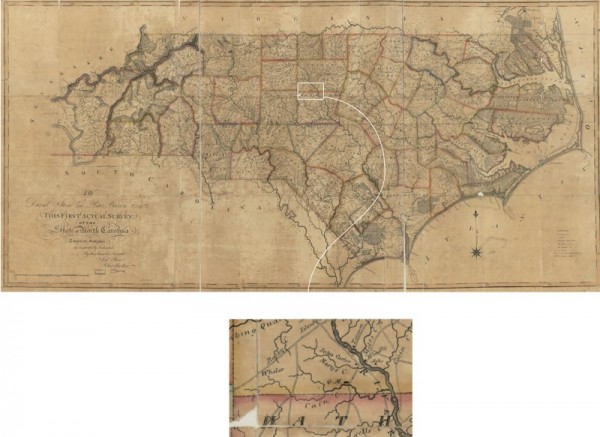
First Actual Survey of the State of North Carolina, Jonathan Price and John Strother (surveyors), W. H. Harrison (engraver), C. P. Harrison (printer), Philadelphia, Pennsylvania, 1807. Ink on paper; 28 3/8" x 59 7/8". (Library of Congress, Geography and Map Division, Washington, DC, G3900 1808 .P7 Vault.)
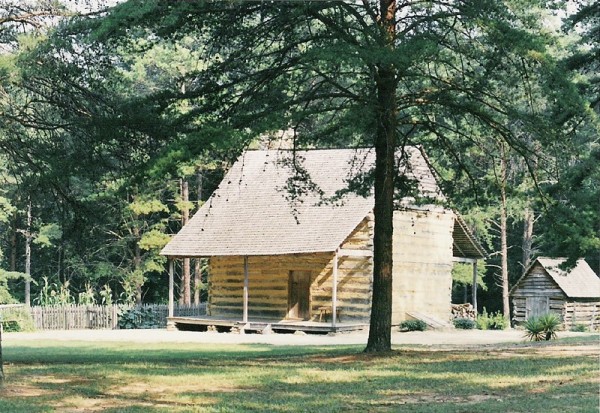
John and Rachel Allen House, Alamance County, North Carolina, 1782. (Courtesy, North Carolina Department of Natural and Cultural Resources.)

Table, Alamance County, North Carolina, 1770–1780. Walnut with yellow pine. H. 27 7/8", W. 36 1/2", D. 30". (Private collection; photo, Wes Stewart.)

Armchair, Alamance or Chatham County, North Carolina, 1770–1780. Maple, hickory with split oak. H. 43 3/4", W. 24", D. 19". (Courtesy, Greensboro Historical Museum; photo, Gary Albert)

Armchair, Alamance or Chatham County, North Carolina, 1770–1780. Hickory with split oak. H. 43 3/4", W. 22", D.18 1/4". (Courtesy, Museum of Early Southern Decorative Ats; photo, Dan Routh.)

Tall case clock, Alamance County, North Carolina, 1790. Walnut, sulfur inlay, and light-wood inlay with tulip poplar and yellow pine. H. 98", W. 17", D. 12". (Private collection; photo, Wes Stewart.)
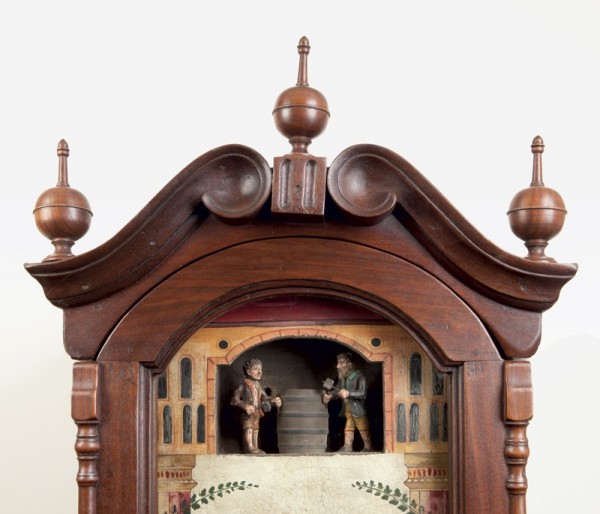
Detail of the scrolled pediment and fluted plinth block on the tall case clock illustrated in fig. 6.

Detail of the applied half columns on the door and hood of the tall case clock illustrated in fig. 6.
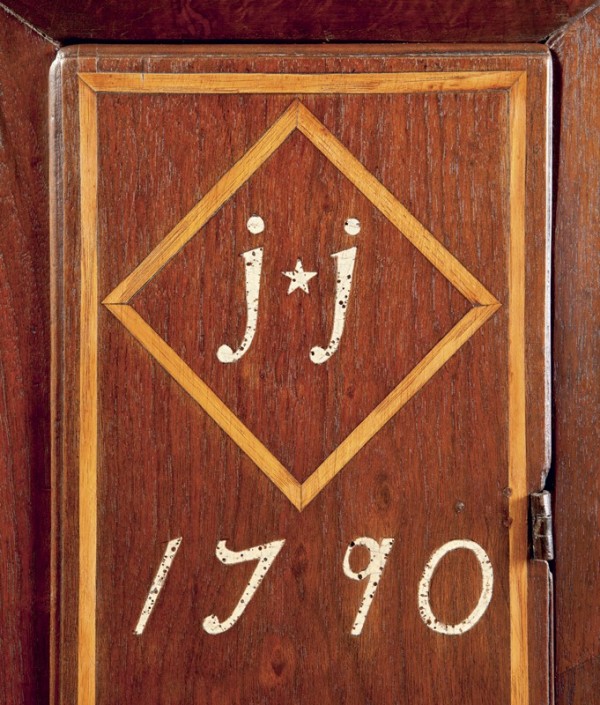
Detail of the wood and sulfur inlay on the door of the tall case clock illustrated in fig. 6.

Tall case clock, Alamance County, North Carolina, 1799. Walnut, sulfur inlay, and light-wood with tulip poplar. H. 93 1/8", W. 18 1/2", D. 18 1/2". (Private collection; photo, Gavin Ashworth.)
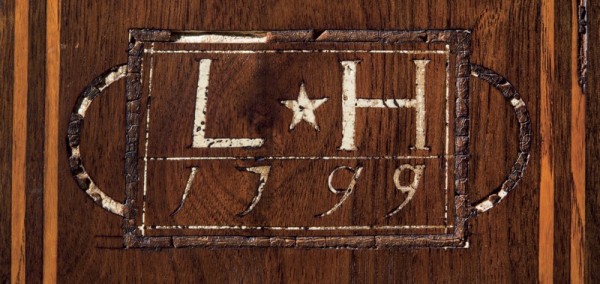
Detail of the sulfur inlay on the tall case clock illustrated in fig. 10. (Photo, Gavin Ashworth.)
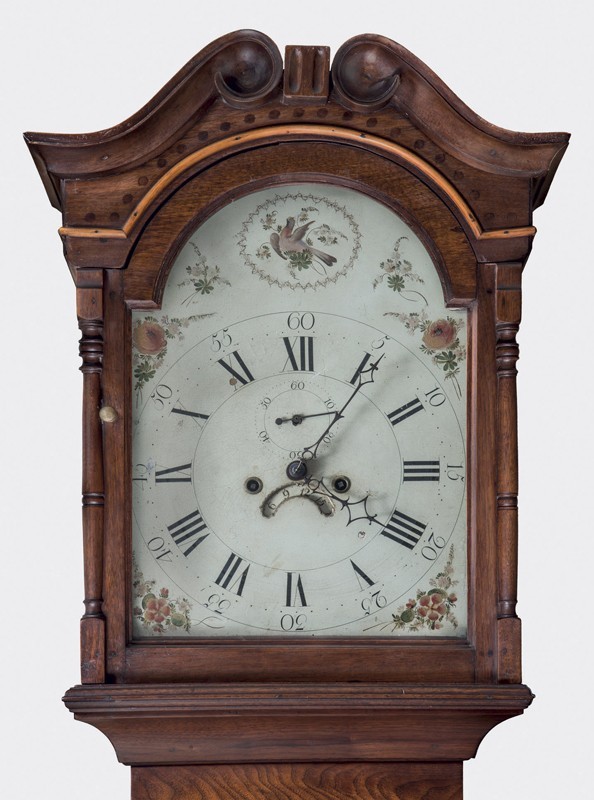
Detail showing the hood decoration on the tall case clock illustrated in fig. 10. (Photo, Gavin Ashworth.)
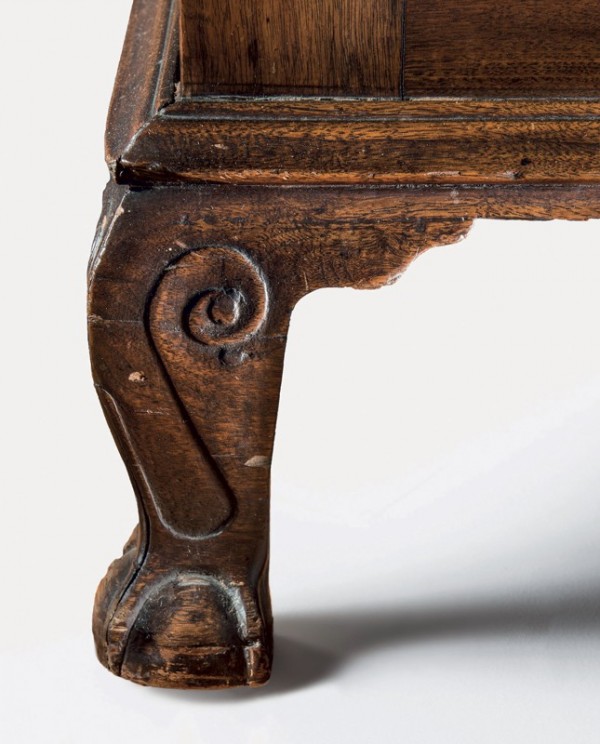
Detail of the left front foot of the tall case clock illustrated in fig. 10. (Photo, Gavin Ashworth.)
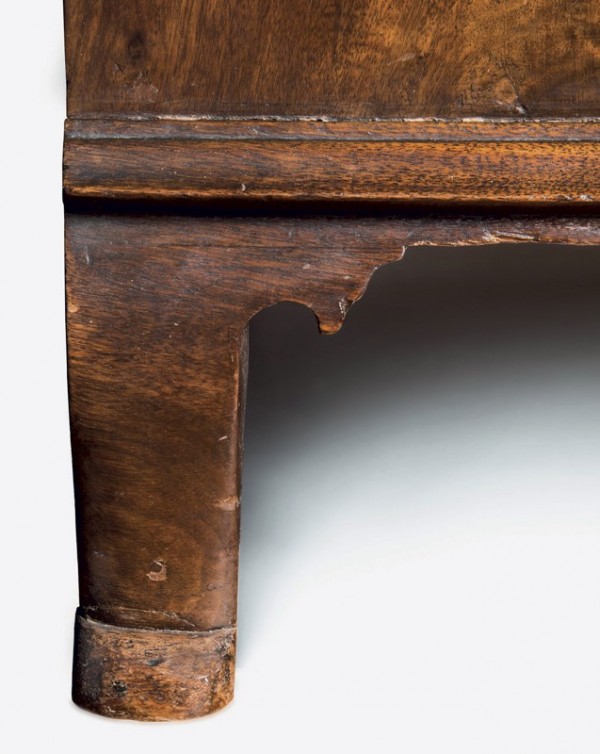
Detail of the left back foot of the tall case clock illustrated in fig. 10. (Photo, Gavin Ashworth.)

Tall case clock, Alamance County, North Carolina, 1790-1805. Walnut and light-wood inlay with yellow pine. H. 99", W. 19", D. 12". (Private collection; photo, Gavin Ashworth).
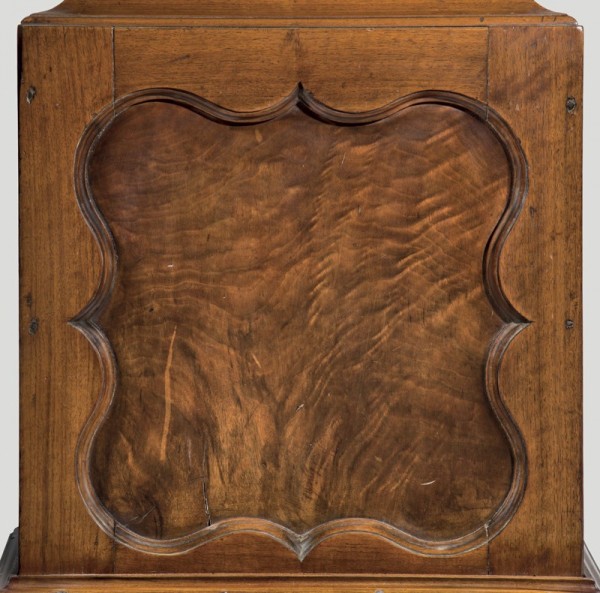
Detail of the scalloped base panel on the tall case clock illustrated in fig. 15. (Photo, Gavin Ashworth.)
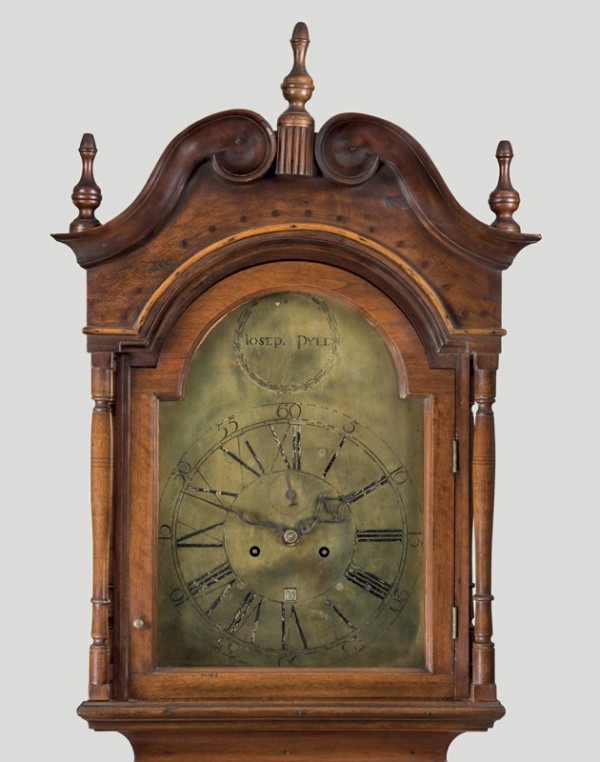
Detail showing the hood decoration on the tall case clock illustrated in fig. 15. (Photo, Gavin Ashworth.)

Detail of a freestanding column on the hood of the tall case clock illustrated in fig. 15. (Photo, Gavin Ashworth.)
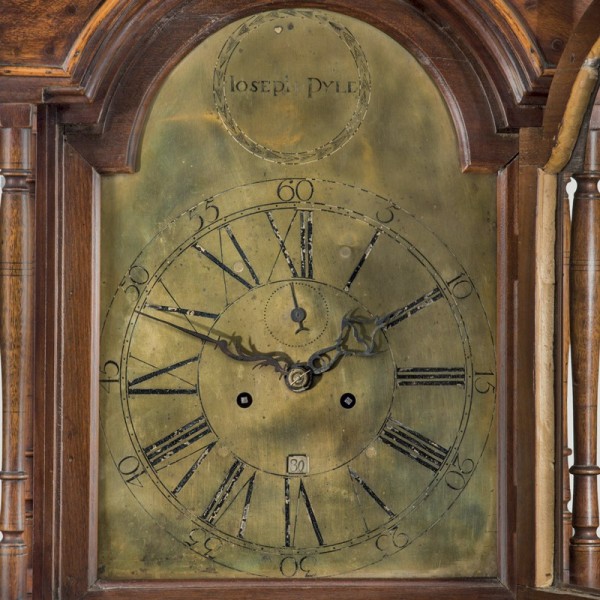
Detail of the brass clock face on the tall case clock illustrated in fig. 15. (Photo, Gavin Ashworth.)
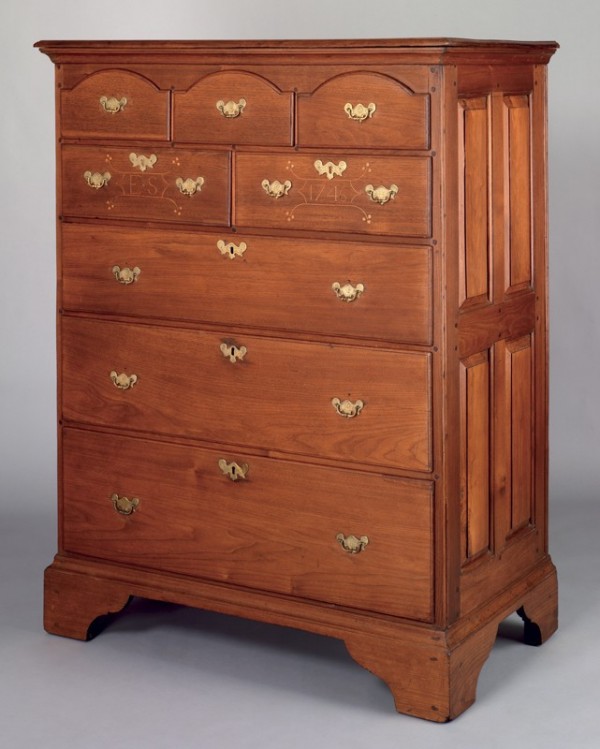
High chest, London Grove Township area, Chester County, Pennsylvania, 1746. Walnut and holly with white oak, white cedar, white pine, and sumac. H. 52 3/8", W. 40 3/4", D. 22 1/4". (Courtesy, The Dietrich American Foundation.)

High chest, Alamance County, North Carolina, 1796. Walnut and sulfur inlay with tulip poplar. H. 56", W. 41 1/2", D. 20 3/8". (Courtesy, Museum of Early Southern Decorative Arts; photo, Wes Stewart.)
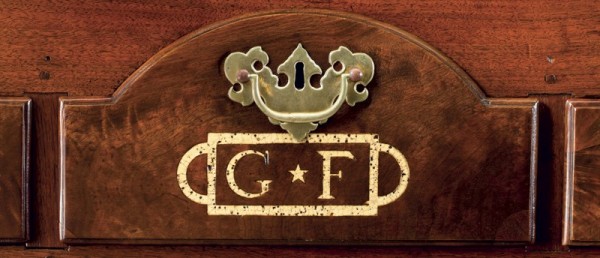
Detail of the sulfur inlay on the high chest illustrated in fig. 21.
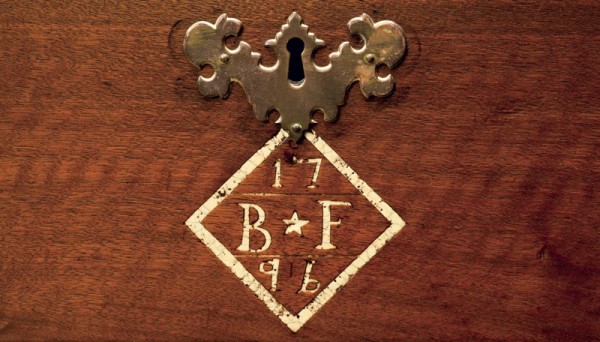
Detail of the sulfur inlay on the high chest illustrated in fig. 21.
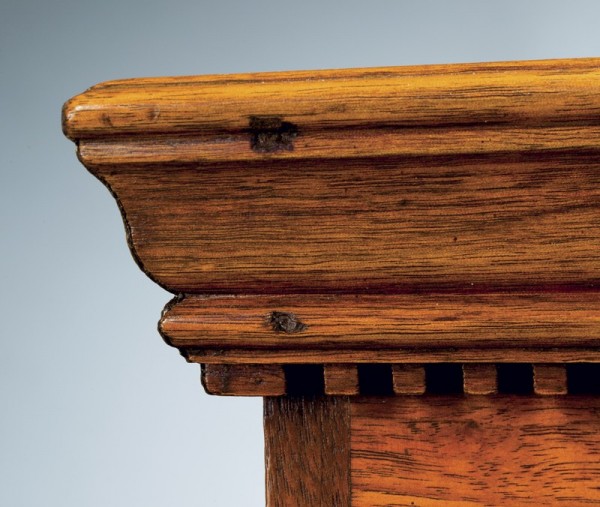
Detail of the cornice molding on the high chest illustrated in fig. 21.

Detail of the front left ogee foot and integral protruding base molding of the high chest illustrated in fig. 21.
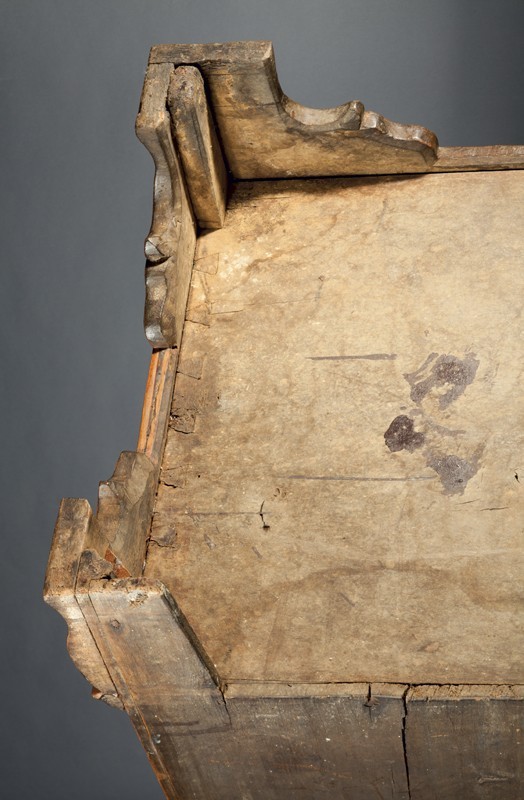
Detail of the underside of the high chest illustrated in fig. 21. The bottom board is dovetailed to the case sides, and the back edges of the feet are slightly chamfered.
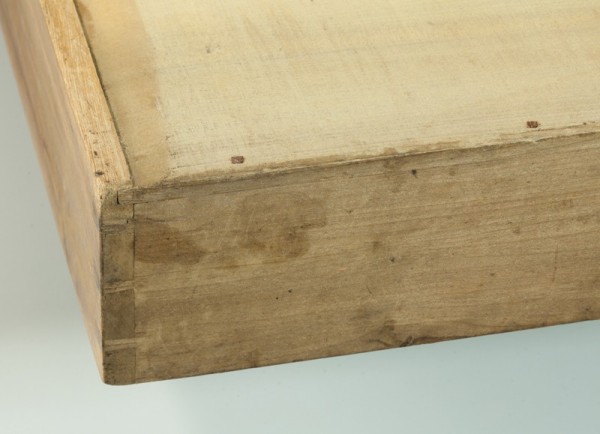
Detail of a pinned drawer bottom from the high chest illustrated in fig. 21.

High chest, Alamance County, North Carolina, 1790–1805. Walnut and sulfur inlay with tulip poplar. H. 58 1/2", W. 42 1/2", D. 20 1/2". (Private collection; photo, Wes Stewart.)
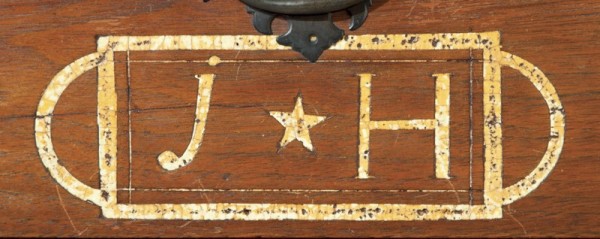
Detail of the sulfur inlay on the high chest illustrated in fig. 28.

Detail of the left front foot of the high chest illustrated in fig. 28. The bottom of the foot retains its beaded edge, a feature that is sometimes either worn or cut off.
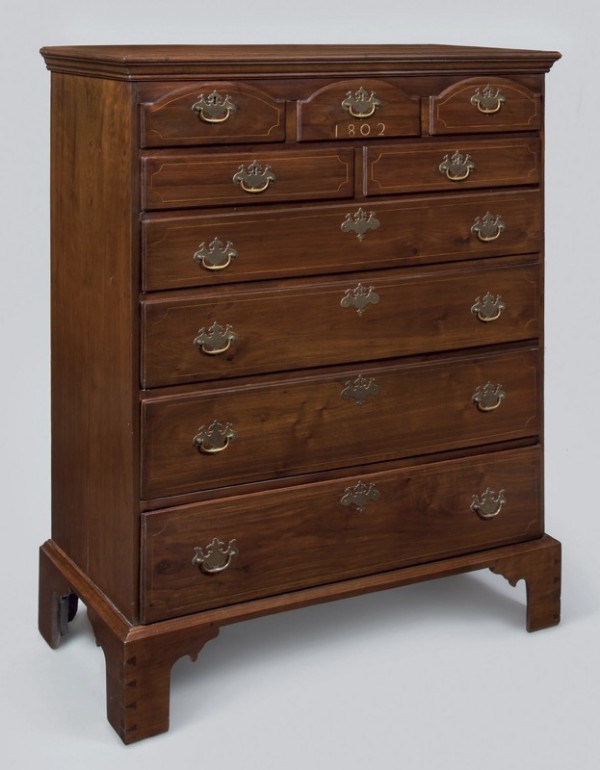
High chest, Alamance County, North Carolina, 1802. Walnut, sulfur inlay, and light-wood inlay with tulip poplar. H. 58 3/4", W. 43", D. 20". (Private collection; photo, Gavin Ashworth).
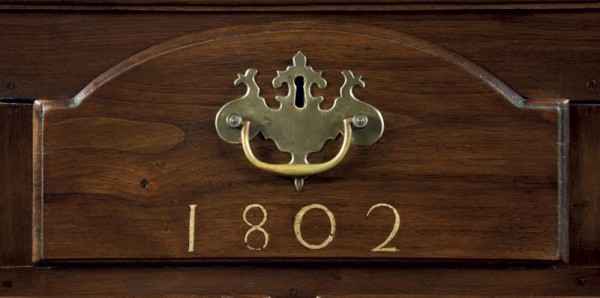
Detail of the sulfur inlay on the high chest illustrated in fig. 31. (Photo, Gavin Ashworth.)
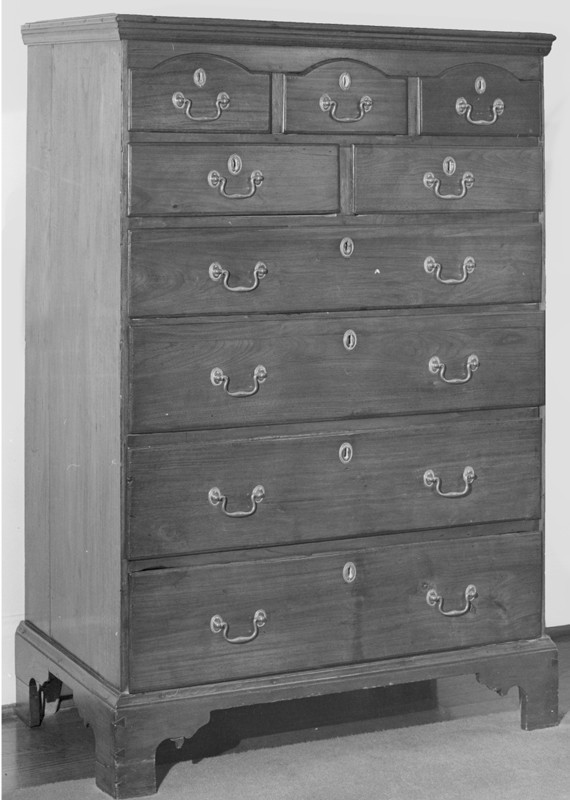
High chest, Alamance County, North Carolina, 1790–1805. Walnut with tulip poplar. H. 55", W. 37 1/2", D. 20 5/8". (Private collection; photo, Museum of Early Southern Decorative Arts.) One atypical construction technique used here is side boards that are splined together and pinned once on each side of the spline.

Detail of the cornice molding on the high chest illustrated in fig. 33.
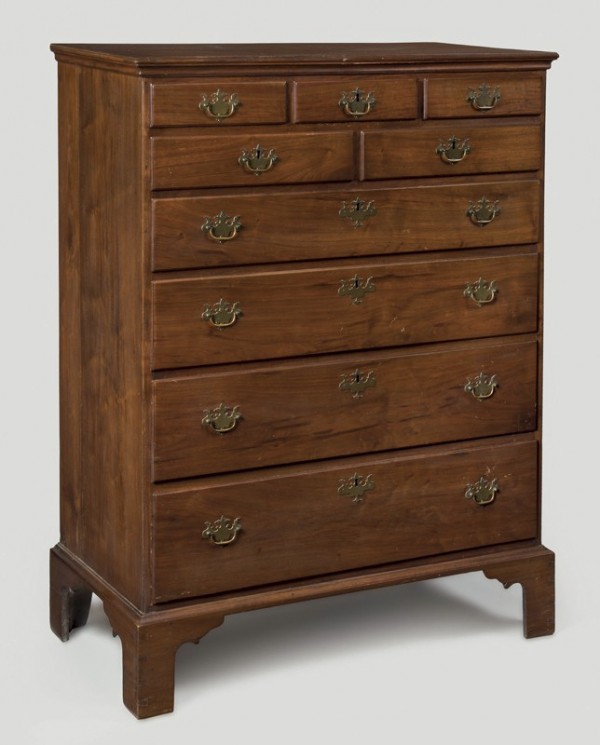
High chest, Alamance County, North Carolina, 1790–1805. Walnut with tulip poplar. H. 56 3/4", W. 42 1/4", D. 21 1/22". (Private collection; photo, Gavin Ashworth.) This high chest has a small hidden drawer above the upper left small drawer.
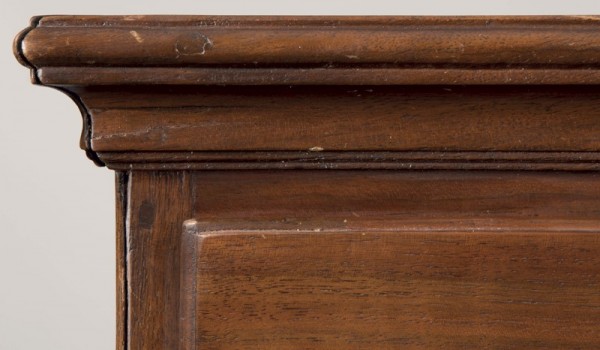
Detail of the cornice molding on the high chest illustrated in fig. 35. (Photo, Gavin Ashworth.)
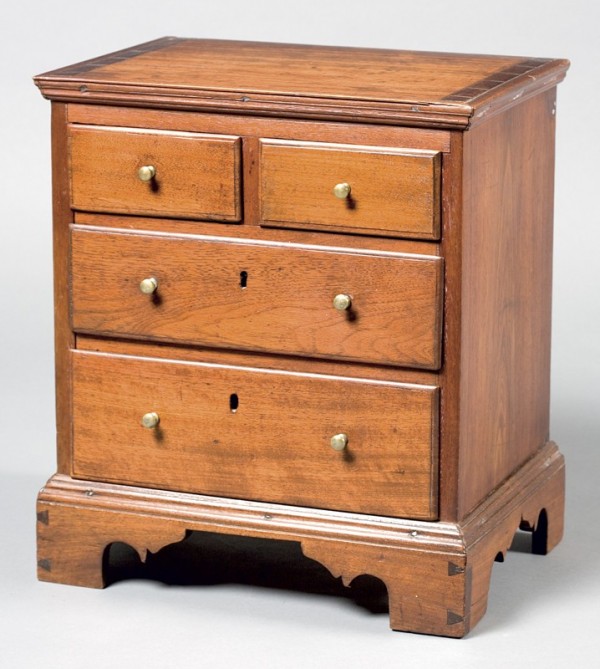
Chest of drawers, Alamance County, North Carolina, 1790–1805. Walnut with yellow pine. H. 18 1/8", W. 15 7/8", D. 11 1/4". (Private collection; photo, Wes Stewart).
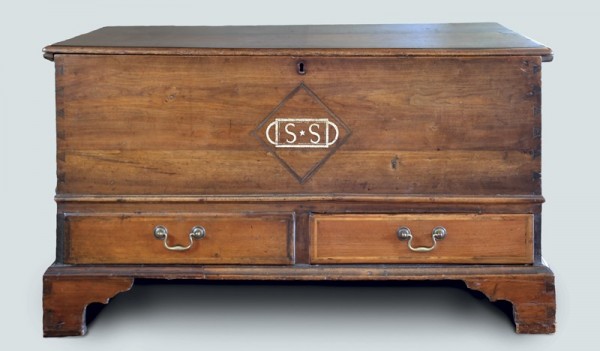
Chest, Alamance County, North Carolina, 1790–1805. Walnut, sulfur inlay, and light-wood inlay with tulip poplar. H. 25 7/8", W. 47 7/8", D. 20 5/8". (Private collection; photo, Gary Albert.)
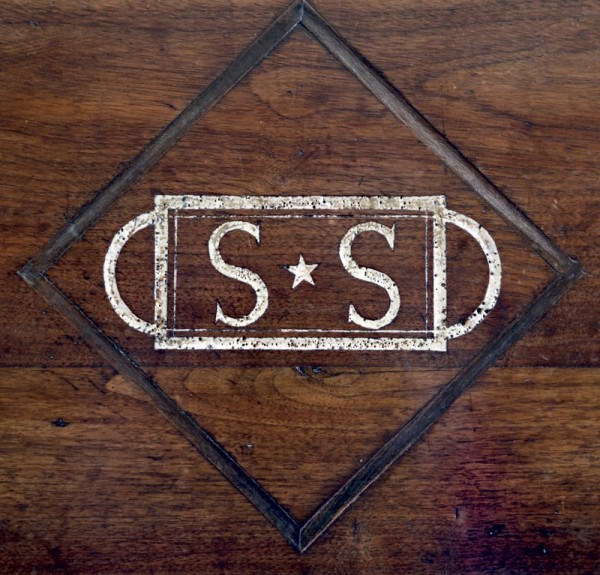
Detail of the sulfur and wood inlay on the chest illustrated in fig. 38.
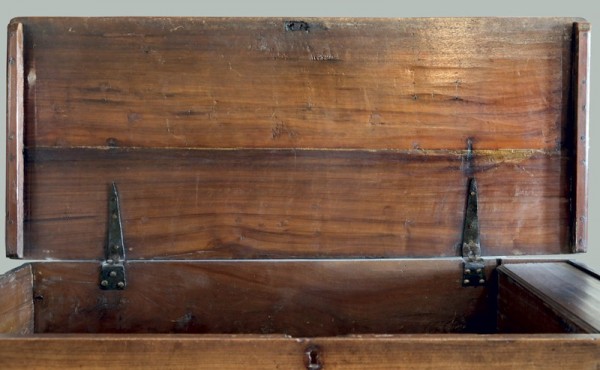
Detail showing the pinned battens on the lid of the chest illustrated in fig. 38.

Chest, Alamance County, North Carolina, 1790–1805. Walnut and sulfur inlay with tulip poplar. H. 27", W. 50", D. 21". (Courtesy, North Carolina Department of Natural and Cultural Resources; photo, Gavin Ashworth).
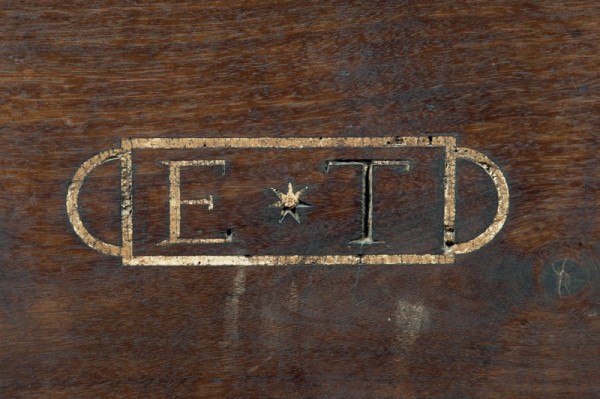
Detail of the sulfur inlay on the chest illustrated in fig. 41. (Photo, Gavin Ashworth.)
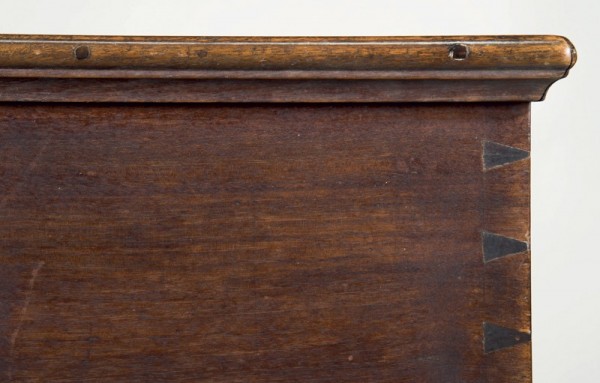
Detail of the pinned molding on the lid of the chest illustrated in fig. 41. (Photo, Gavin Ashworth.)
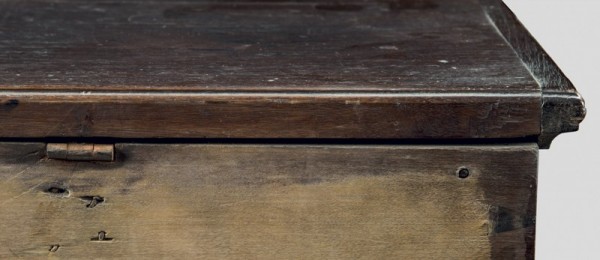
Detail of the bead on the back of the lid on the chest illustrated in fig. 41. (Photo, Gavin Ashworth.)
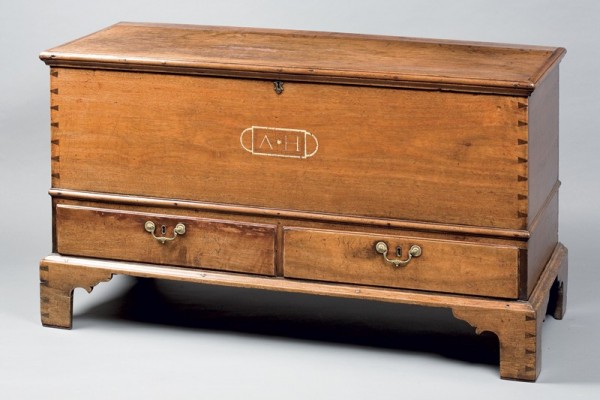
Chest, Alamance County, North Carolina, 1790–1805. Walnut and sulfur inlay with tulip poplar. H. 28", W. 50", D 21 1/2". (Private collection; photo, Wes Stewart).
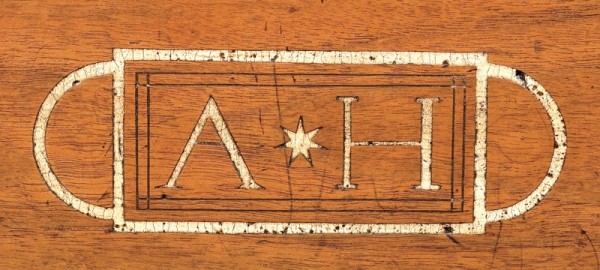
Detail of the sulfur inlay on the chest illustrated in fig. 45.

Chest, Alamance County, North Carolina, 1800. Walnut and sulfur inlay with tulip poplar. H. 25 1/2", W. 48 1/2", D. 20". (Private collection; photo, Wes Stewart.)
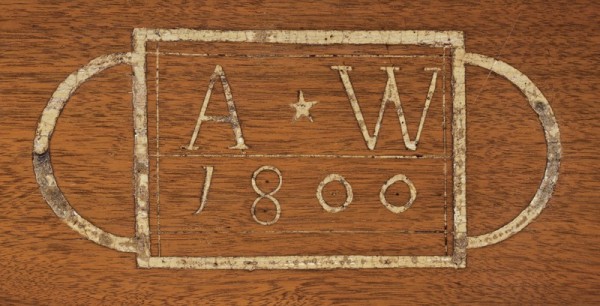
Detail of the sulfur inlay on the chest illustrated in fig. 47.
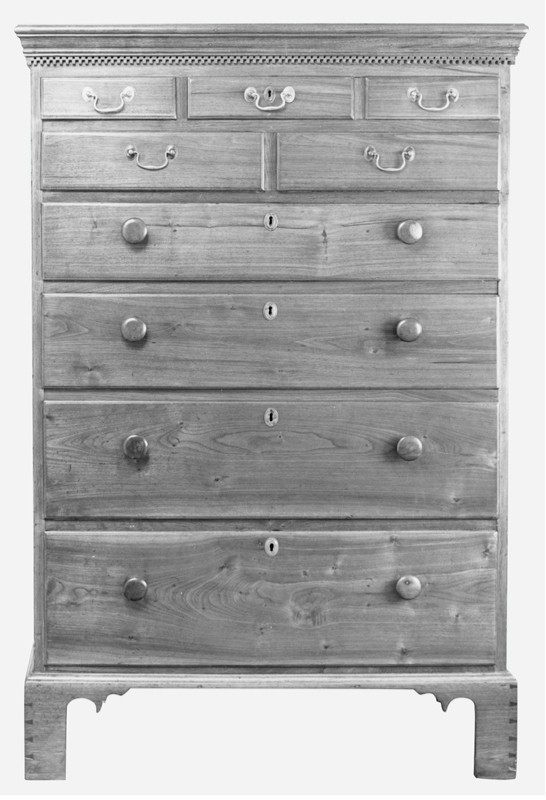
High chest, Alamance or Chatham County, North Carolina, 1800–1815. Walnut with tulip poplar. H. 59 1/2", W. 40", D. 21 3/4". (Private collection; photo, Museum of Early Southern Decorative Arts.) The sides extend to form foot supports, but the sides are dovetailed to the bottom in between the extensions; this same construction technique was used on the high chests illustrated in figs. 21, 28, 31, 33, and 35.
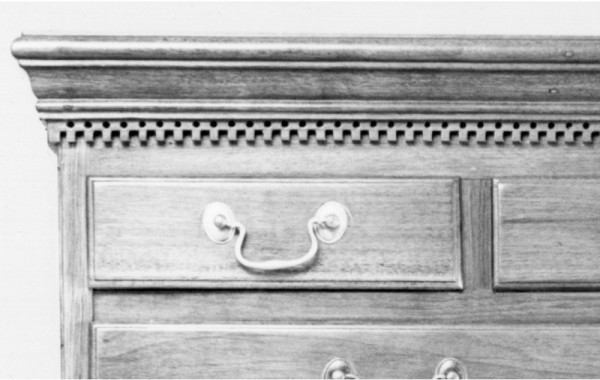
Detail of the cornice molding with a drilled dot and dentil band on the high chest illustrated in fig. 49.
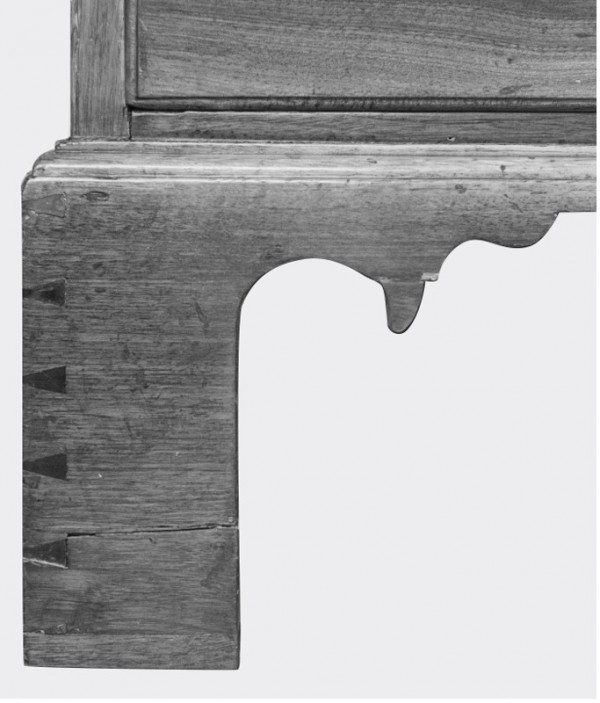
Detail of the left front foot of the high chest illustrated in fig. 49.
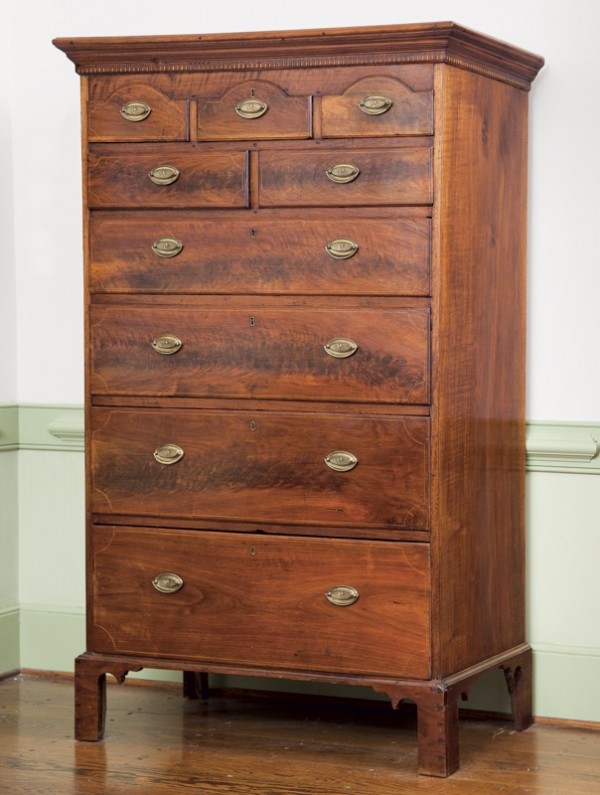
High chest, Alamance or Chatham County, North Carolina, 1800–1815. Walnut and light-wood inlay with tulip poplar. H. 70 1/2", W. 43 1/2", D. 22 1/2". (Private collection; photo, Wes Stewart.) Drawer bottoms on this example are nailed rather than pinned.
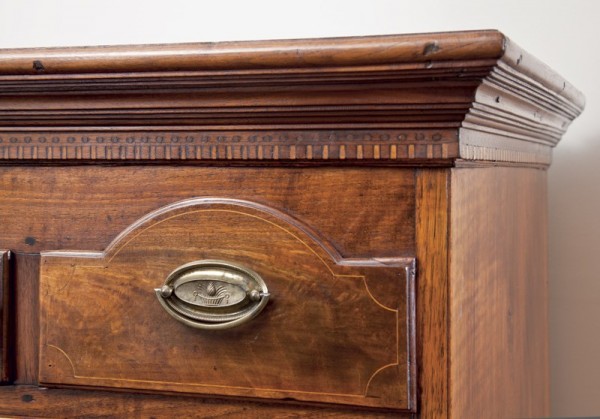
Detail of the cornice molding and upper left drawer of the high chest illustrated in fig. 52. All drawers have light-wood stringing.

Detail of the left front foot of the high chest illustrated in fig. 52. Instead of a beaded bottom edge, this example has a bottom edge decorated with string inlay.
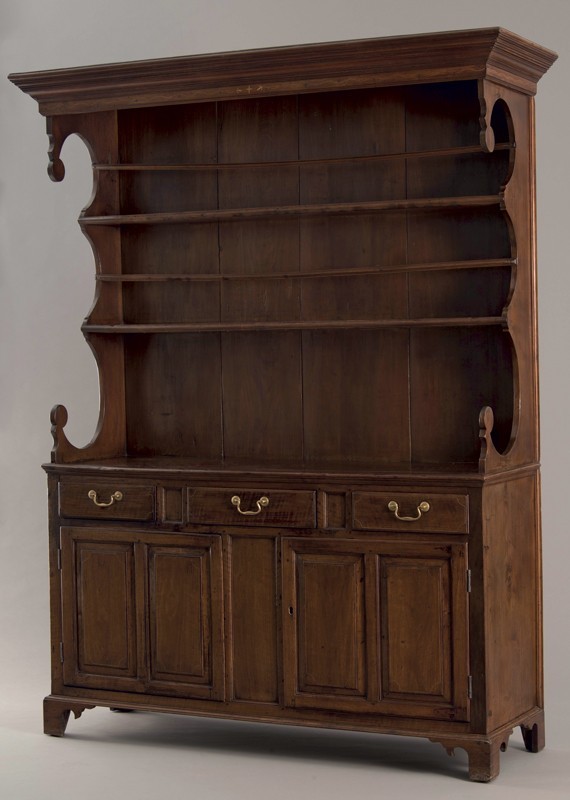
Dish dresser, Alamance or Chatham County, North Carolina, 1800–1815. Walnut and light-wood inlay with tulip poplar and cherry. H. 85 1/4", W. 61 1/4", D. 19 1/2". (Courtesy, Colonial Williamsburg Foundation.) The doors have raised panels which, along with the drawer fronts, are decorated with string inlay like that found on the high chests illustrated in figs. 31 and 52.
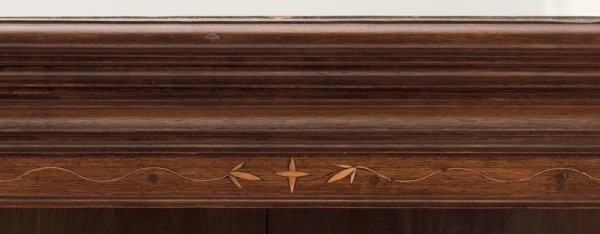
Detail of the frieze on the dish dresser illustrated in fig. 55. )
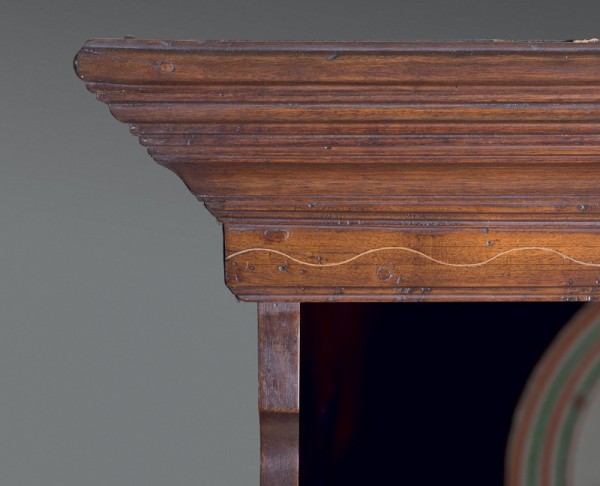
Detail of the cornice molding and frieze on the dish dresser illustrated in fig. 55.
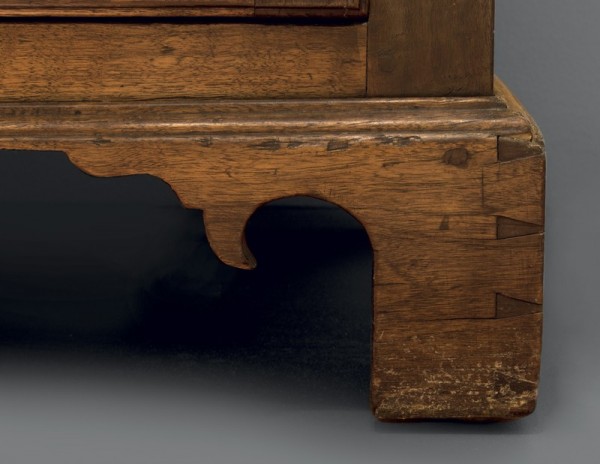
Detail of the right front foot of the dish dresser illustrated in fig. 55.
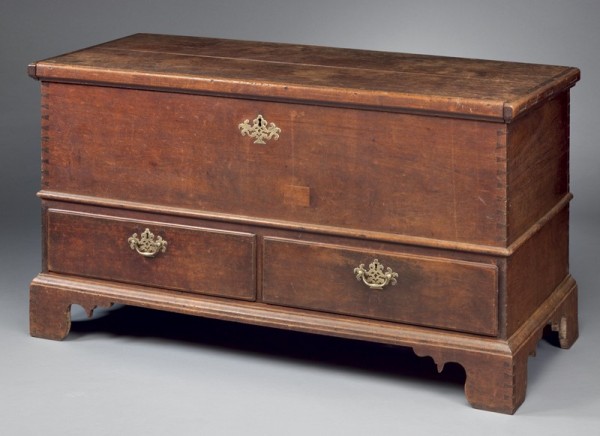
Chest by Jeremiah Piggott and Joseph Cloud, Chatham County, North Carolina, 1800. Walnut with tulip poplar. H. 28 3/4", W. 51 1/2", D 22 1/2". (Private collection; photo, Wes Stewart.)
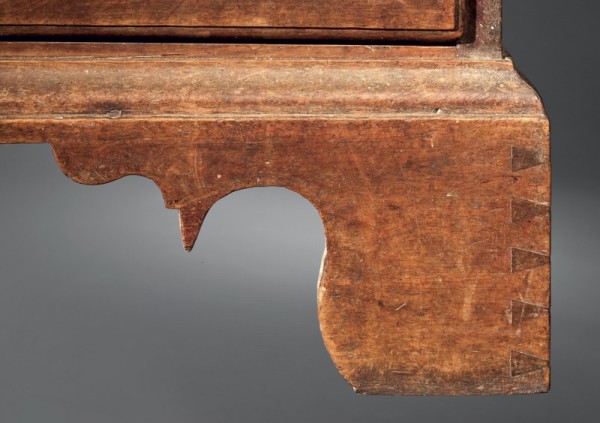
Detail of the right front foot of the chest illustrated in fig. 59.

Detail showing the through tenons securing the side molding on the chest lid of the chest illustrated in fig. 59.

Details showing the removable board above the two drawers of the chest illustrated in fig. 59.
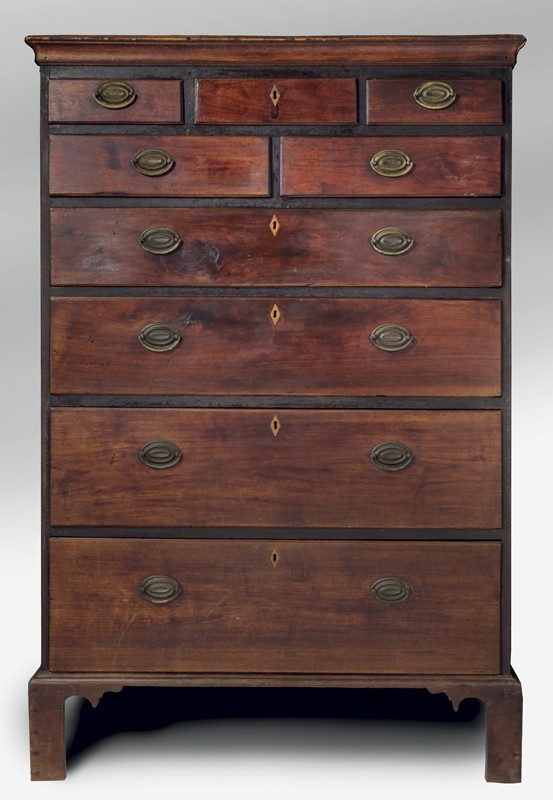
High chest by John Piggott, Chatham County, North Carolina, 1810–1835. Walnut with tulip poplar. H. 59 3/8", W. 40 3/16", D. 22 5/16". (Courtesy, Greensboro Historical Museum; photo, Gary Albert.) The drawer bottoms, cornice molding, and backboards are attached with small wooden pins. The sides extend to support the case, but the bottom boards are nailed to the sides instead of being dovetailed.

Detail of the cornice molding on the high chest illustrated in fig. 63.
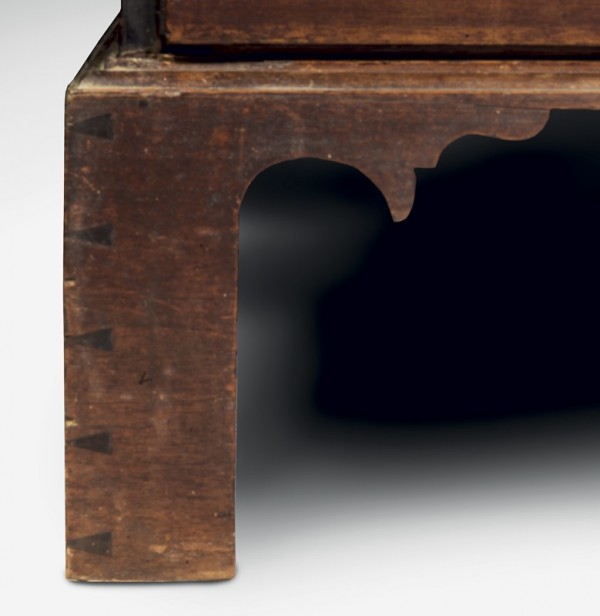
Detail of the left front foot of the high chest illustrated in fig. 63.

High chest, Chatham County, North Carolina, 1810–1835. Walnut with tulip poplar. H. 59 5/8", W. 39 3/4", D. 19 1/2". (Private collection; photo, Wes Stewart.)
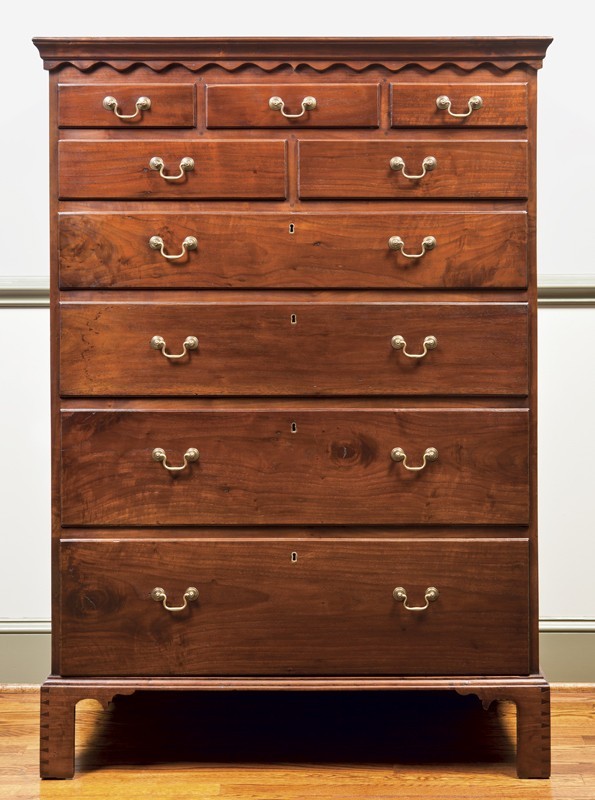
High chest, Chatham County, North Carolina, 1810–1835. Walnut with yellow pine. H. 60", W. 42", D. 22". (Private collection; photo, Wes Stewart.)

Detail of the left front foot of the high chest illustrated in fig. 67.

Tall case clock, Chatham County, North Carolina, 1800–1820. Walnut with yellow pine. H. 96 1/2", W. 20 1/2", D. 12 1/2". (Private collection; photo, Wes Stewart.)

Detail of the pediment of the tall case clock illustrated in fig. 69.
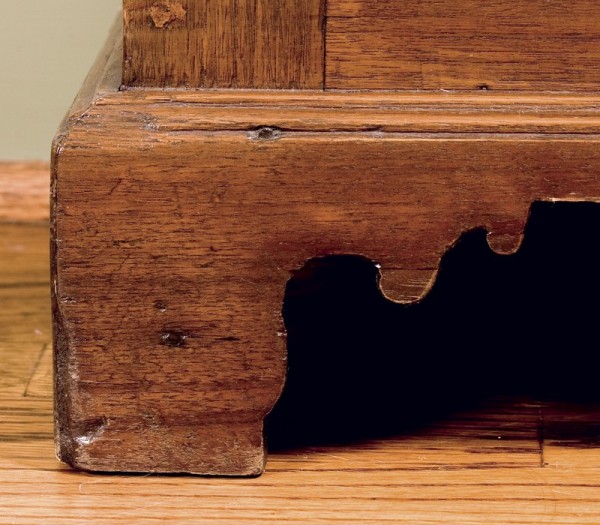
Detail of the left front foot of the tall case clock illustrated in fig. 69.

Tall case clock, Chatham County, North Carolina, 1800–1820. Walnut with tulip poplar. H. 96", W. 19 1/2 D. 12". (Courtesy, North Carolina Department of Natural and Cultural Resources; photo, Gavin Ashworth.)
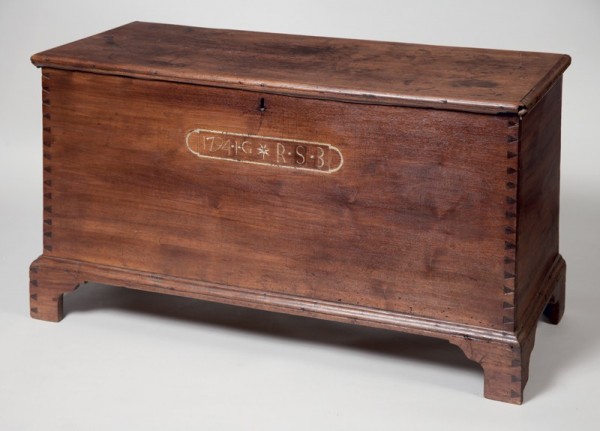
Chest, probably Randolph County, North Carolina, 1794. Walnut and sulfur with tulip poplar and yellow pine. H. 24", W. 45 1/4", D. 18 1/2". (Private collection; photo, Wes Stewart.)

Detail of the sulfur inlay on the chest illustrated in fig. 73.
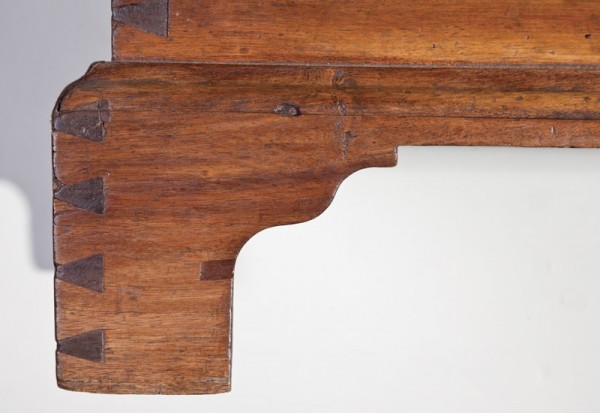
Detail of the left front foot of the chest illustrated in fig. 73.

Detail of a foot support block on the chest illustrated in fig. 73.
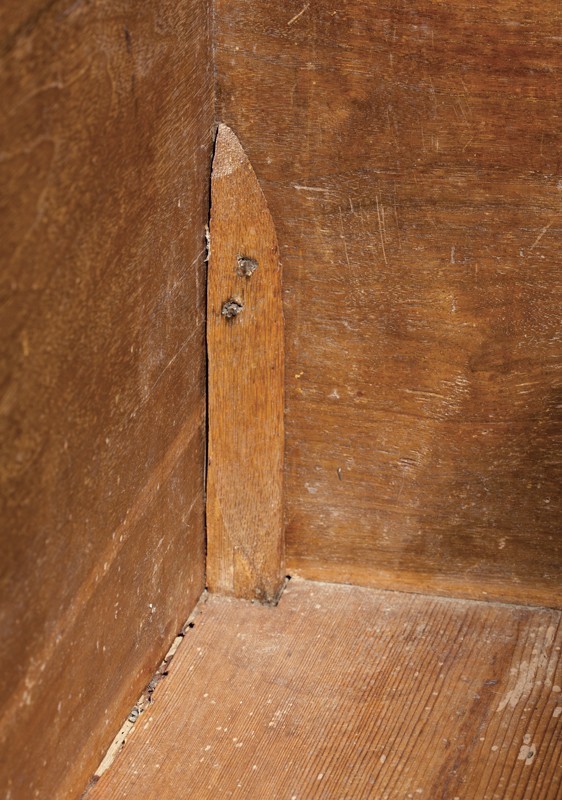
Detail showing a support block extending through the bottom of the chest illustrated in fig. 73.
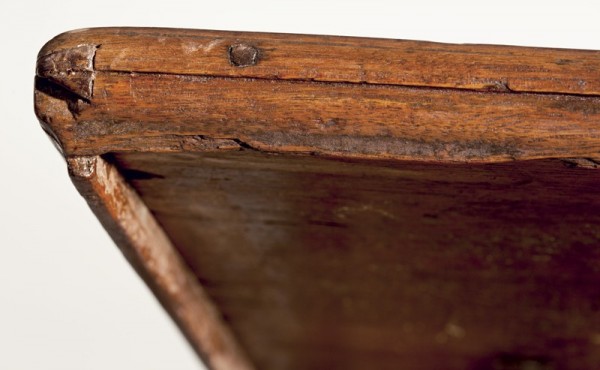
Detail showing the lid construction of the chest illustrated in fig. 73.
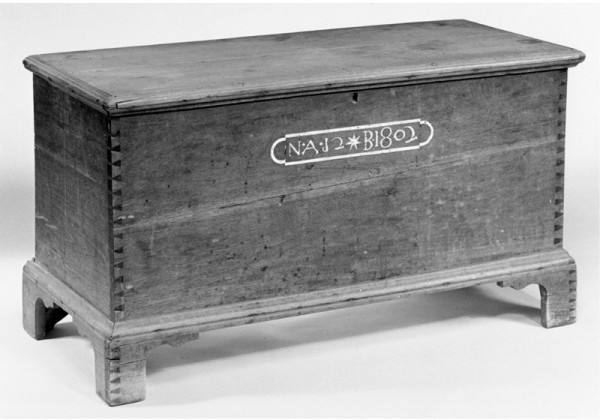
Chest, probably Randolph County, North Carolina, 1802. Walnut and sulfur inlay with tulip poplar. H. 23 1/2", W. 41 3/4", D. 18 7/8". (Private collection; photo, Museum of Early Southern Decorative Arts.)
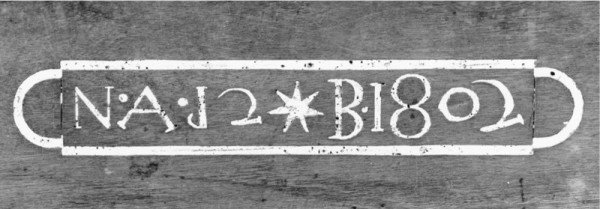
Detail of the sulfur inlay on the chest illustrated in fig. 79.

Detail of the left front foot of the chest illustrated in fig. 79. This foot is attached to a coved glue block that extends through the chest bottom, a construction detail identical to that on the chest illustrated in fig. 73.
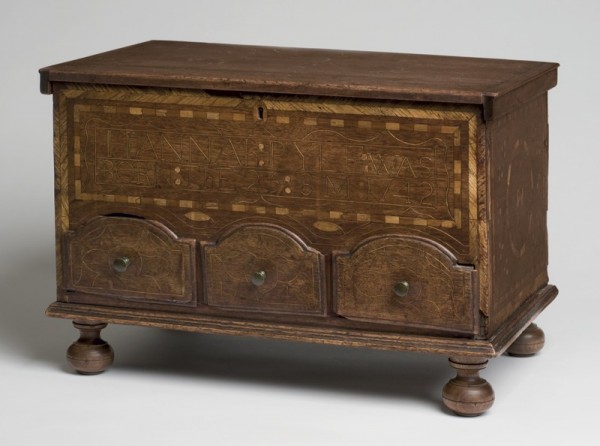
Chest, attributed to Moses Pyle, Chester County, Pennsylvania, 1746. Walnut and mixed wood inlay with yellow pine. H. 11 3/4", W. 21", D. 13". (Courtesy, Philadelphia Museum of Art.)
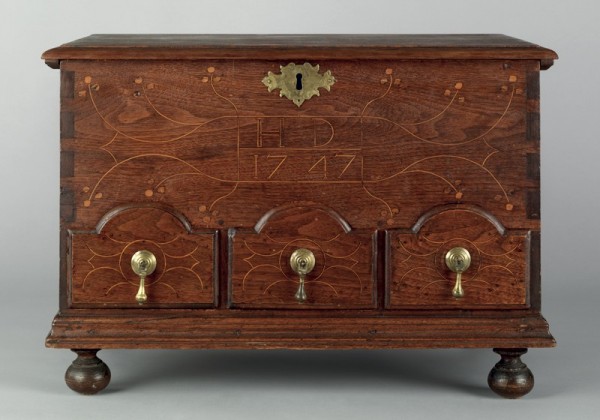
Chest, attributed to Moses Pyle, Chester County, Pennsylvania, 1747. Walnut; sumac, maple, and holly inlay with white oak, white cedar, and tulip poplar. H. 14 1/2", W. 21 1/8", D. 131/2". (Courtesy, Winterthur Museum.)
